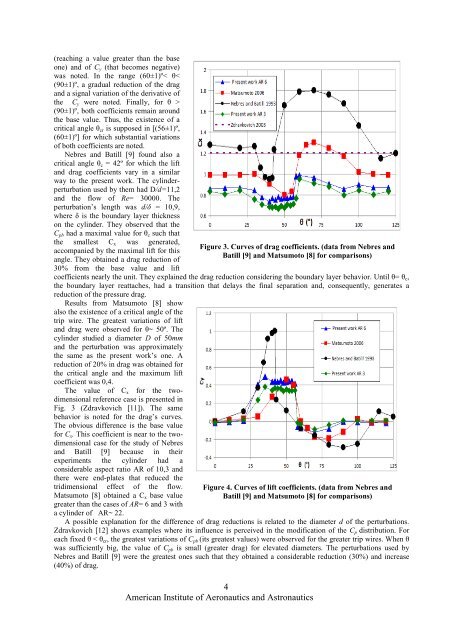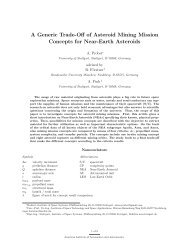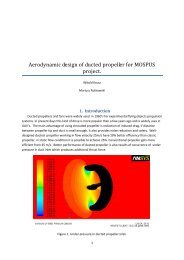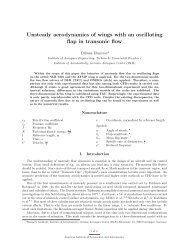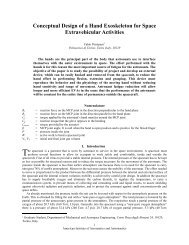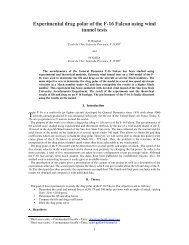Passive flow control around a wall-mounted finite cylinder - Pegasus
Passive flow control around a wall-mounted finite cylinder - Pegasus
Passive flow control around a wall-mounted finite cylinder - Pegasus
Create successful ePaper yourself
Turn your PDF publications into a flip-book with our unique Google optimized e-Paper software.
(reaching a value greater than the base<br />
one) and of C y (that becomes negative)<br />
was noted. In the range (60±1)º< θ<<br />
(90±1)º, a gradual reduction of the drag<br />
and a signal variation of the derivative of<br />
the C y were noted. Finally, for θ ><br />
(90±1)º, both coefficients remain <strong>around</strong><br />
the base value. Thus, the existence of a<br />
critical angle θ cr is supposed in [(56±1)º,<br />
(60±1)º] for which substantial variations<br />
of both coefficients are noted.<br />
Nebres and Batill [9] found also a<br />
critical angle θ c = 42º for which the lift<br />
and drag coefficients vary in a similar<br />
way to the present work. The <strong>cylinder</strong>perturbation<br />
used by them had D/d=11,2<br />
and the <strong>flow</strong> of Re= 30000. The<br />
perturbation’s length was d/δ = 10,9,<br />
where δ is the boundary layer thickness<br />
on the <strong>cylinder</strong>. They observed that the<br />
C pb had a maximal value for θ c such that<br />
the smallest C x was generated,<br />
accompanied by the maximal lift for this<br />
angle. They obtained a drag reduction of<br />
30% from the base value and lift<br />
coefficients nearly the unit. They explained the drag reduction considering the boundary layer behavior. Until θ= θ c ,<br />
the boundary layer reattaches, had a transition that delays the final separation and, consequently, generates a<br />
reduction of the pressure drag.<br />
Results from Matsumoto [8] show<br />
also the existence of a critical angle of the<br />
trip wire. The greatest variations of lift<br />
and drag were observed for θ~ 50º. The<br />
<strong>cylinder</strong> studied a diameter D of 50mm<br />
and the perturbation was approximately<br />
the same as the present work’s one. A<br />
reduction of 20% in drag was obtained for<br />
the critical angle and the maximum lift<br />
coefficient was 0,4.<br />
The value of C x for the twodimensional<br />
reference case is presented in<br />
Fig. 3 (Zdravkovich [11]). The same<br />
behavior is noted for the drag’s curves.<br />
The obvious difference is the base value<br />
for C x . This coefficient is near to the twodimensional<br />
case for the study of Nebres<br />
and Batill [9] because in their<br />
experiments the <strong>cylinder</strong> had a<br />
considerable aspect ratio AR of 10,3 and<br />
there were end-plates that reduced the<br />
tridimensional effect of the <strong>flow</strong>.<br />
Matsumoto [8] obtained a C x base value<br />
greater than the cases of AR= 6 and 3 with<br />
a <strong>cylinder</strong> of AR~ 22.<br />
Figure 3. Curves of drag coefficients. (data from Nebres and<br />
Batill [9] and Matsumoto [8] for comparisons)<br />
Figure 4. Curves of lift coefficients. (data from Nebres and<br />
Batill [9] and Matsumoto [8] for comparisons)<br />
A possible explanation for the difference of drag reductions is related to the diameter d of the perturbations.<br />
Zdravkovich [12] shows examples where its influence is perceived in the modification of the C p distribution. For<br />
each fixed θ < θ cr , the greatest variations of C pb (its greatest values) were observed for the greater trip wires. When θ<br />
was sufficiently big, the value of C pb is small (greater drag) for elevated diameters. The perturbations used by<br />
Nebres and Batill [9] were the greatest ones such that they obtained a considerable reduction (30%) and increase<br />
(40%) of drag.<br />
4<br />
American Institute of Aeronautics and Astronautics


